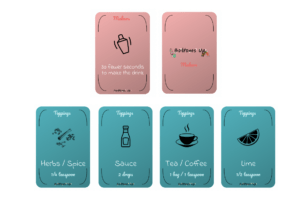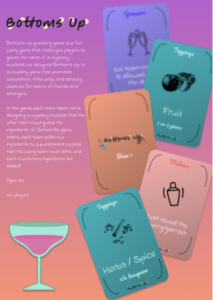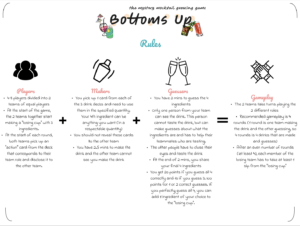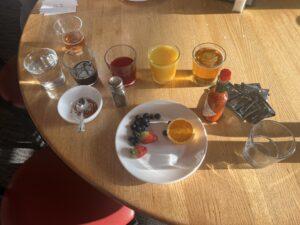Artistic Statement
Premise
Bottoms Up guessing game is a fun party game that challenges players to guess the name of a mystery mocktail. We designed Bottom’s Up to be a party game that promotes competition, fellowship, and sensory pleasure for teams of friends and strangers. In this game, each team takes turns designing a mystery mocktail that the other team must guess the ingredients of. Before the game starts, each team adds two ingredients to a punishment cocktail that the losing team must drink, and each round more ingredients are added!
In each round, each team will draw cards and use those specifications to prepare a mocktail using a variety of non-alcoholic ingredients. The other players must then taste the mocktail and try to guess its name based on the taste, smell, and appearance of the drink. The more ingredients you guess, the more points you can win! Each round also includes specific action cards that may offer advantages/disadvantages to the Mixers and Tasters with each turn. This game is perfect for parties or gatherings and can be played by people of all ages. It not only tests your taste buds but also your creativity in coming up with unique names for your mocktail creation. So, let the mocktail guessing game begin!
Context
In today’s fast-paced and technology-driven world, parties have become more isolated and less interactive. Social games have become increasingly important in breaking the ice and fostering social connections between people. Parties today need games that promote social interaction, create a relaxed and friendly atmosphere, and provide a sense of fun and enjoyment for everyone. Social games can act as a catalyst for engaging conversations, facilitate new friendships, and provide a platform for people to showcase their skills and talents. Games like Bottom’s Up, for example, not only entertain but also promote creativity and imagination, essential for building social connections. The game provides a platform for players to showcase their bartending skills and knowledge of flavors and ingredients, and in doing so, it encourages them to share and communicate their experiences and knowledge with others. This type of social interaction can increase feelings of social connectedness, reduce social anxiety, and improve overall well-being.
Learning Outcomes
Bottom’s Up has 3 main learning outcomes:
- Creativity and Innovation: The game encourages players to use their creativity and imagination to come up with unique mocktail recipes given the initial scope. This type of game promotes thinking outside the box and developing new ideas, which can transfer to other areas of life, including problem-solving and decision-making.
- Social Skills: This game promotes social skills such as communication, teamwork, and positive interaction, essential for developing healthy relationships. Players have to communicate their ideas to create the mocktail and work together to guess the mocktail’s ingredients, promoting cooperation and social bonding.
- Knowledge of Flavors and Ingredients: The game also enhances players’ knowledge of flavors and ingredients, which can be valuable for individuals interested in bartending, cooking, or hosting events. Players can learn about various non-alcoholic ingredients, their flavors, and how they can be combined to create delicious mocktails, which can be useful knowledge for other social events or entertaining guests at home.
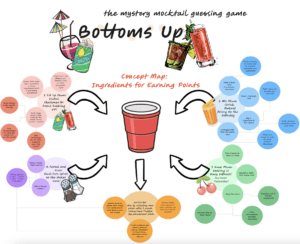
Initial Decisions about Formal Elements and Values of Your Game
Because we knew the initial design specification was to design a social game, we considered several aesthetics from the MDA framework based on that. We first brainstormed the core actions of a party: interacting with your friends, meeting new people, getting something to drink, having fun. We then tried to pair each core action to a mechanism that would embody that in the game. Firstly, for interacting with your friends, we decided to create the mechanism of teams of 2 to make the drink to have the aesthetic of fellowship. That way, friends are incentivized to work together towards a common goal. Moreover, for meeting new people, we wanted a creative way that can break the ice for two people meeting for the first time. Which is why we decided to add the component of having to guess the ingredients in the mocktail, and inspire the use of a sensory experience that is unknown to bond. That also came in hand with having people role playing as mixologists, as they have to experiment with new ingredients, which adds the aesthetic of fantasy. Thirdly, to get something to drink, we decided that teams should experiment to make their own mocktail with unconventional ingredients, and initiate the aesthetic of having a discovery phase. Finally, for having fun, we added time constraints to make the mocktail and to guess ingredients, creating challenge and retainment. With these 4 core elements in mind, we started hashing out more mechanics of the guessing game to add to its complexity.
Testing and iteration history
Game
Below are our main playtests that we used to iterate our game. We kept in mind Shana’s feedback at every point and made sure that it was addressed
Playtest 1
- Who participated?
- We conducted this playtest in class and had 4 participants (2 on each team). None of the participants were from our team.
- State of the game
- At this point, we were in the initial states. One team was given 5 minutes to make a mystery drink (they were given 8 ingredients and could only use 4) and the other team had to guess the 4 ingredients in 5 minutes (they knew that the drink had 4 ingredients).
- Key assumptions we were testing/questions we were looking to answer
- Is the time enough? Is it too short?
- How does the time contribute to making the game engaging?
- Can players understand the game easily?
- How many questions do players ask before the start of the game?
- What do we have to repeat multiple times?
- How will guessing work in a team? How will the players interact with each other?
- Is it actually difficult for a team to pick up the ingredients? How can we make it the right level of challenge?
- Is the time enough? Is it too short?
- What we learned/decided
- 5 minutes is too much to make a drink (this part can be done in 3 minutes), especially if we have a narrow set of ingredients
- Rules need to be more clear
- Is there a minimum quantity of each ingredient that needs to be put for the game to be “fair”?
- Can the guessing team just keep guessing ingredients until they land on the correct ones? Or do they have a limited number of tries? How do we get a right balance of challenge?
- We need to account for allergies
- Some ingredients are “bad” for the game
- It is almost impossible to guess sugar as an ingredient as most juices already have some sort of sugar
- Seeing the color of the final drink gives away the main base ingredient
- We need to add an element of not being able to see the drink to add to the fellowship aesthetic.
- Interesting behavior
- Some players were trying to game the system by adding small quantities of flavors that are hard to pick up. Ie. using salt as one of the ingredients or a tea bag where the flavor is very mild. We need to redress this by putting set quantities.
Playtest 2
- Who participated
- All 4 members of the team
- State of the game (what changed from the last playtest)
- The game was much more fleshed out at this point
- 3 mins were given to make the drink and 3 mins to guess
- We used the “action” cards – each team picked out a card at the beginning from the deck corresponding to their role for the round (maker or guesser)
- We used cards for making the drink and standardized the quantities- the “makers” team had to choose one base_1 card (3 ounces), one base_2 card (1.5 ounce) and one toppings/garnish card (1 teaspoon). The 4th ingredient could be anything
- Everyone was aware of the ingredients used for game play to account for allergies
- From the guessing team, only one person sees the drink (and this person cannot taste), the rest of the people taste the drink but cannot see it
- Need to make 4 final guesses at the end of the guessing time to make sure there is the aesthetic of challenge
- If you guess 4 (all) ingredients you get 30 points and if you guess 3, you get 10 points (because guessing all is much more rewarding). No points for 1 or 2 correct guesses.
- The game was much more fleshed out at this point
- Key assumptions we were testing/questions we were looking to answer
- How does time feel now (for both teams)?
- How does the mechanic of having drink cards work?
- How do the dynamics of one person seeing the drink and other tasting contribute to the aesthetic of the game?
- How does the game feel with action cards?
- How does the mechanic of scoring work and how does this tie in with the outcome of the game?
- What we learned/decided
- 3 mins to guess can be a lot
- Should do 2.5 mins instead
- 3 mins to make also might be a lot
- Person who sees the drink (and not drinks it) can make guesses as well
- Toppings/garnishes need their own specific quantities for each kind
- 1 teaspoon of tabasco can be A LOT
- If your action card states you need to reveal an ingredient, this needs to be done before the guessing timer starts
- 30 points for 4 and 10 for 3 might be a lot of difference as you will need a lot of rounds to make up for that loss
- Decided on 20 points for 4 correct and 10 for 3
- 3 mins to guess can be a lot
Playtest 3
- Who participated
- 2 members of our team and 2 random stanford students
- State of the game (what changed from the last playtest)
- The guessing team had 2.5 mins now instead of 3
- 20 points for 4 correct and 10 for 3
- Key assumptions we were testing/questions we were looking to answer
- How does time feel now (for both teams)?
- How does the mechanic of scoring work? Does it motivate and engage players?
- What we learned/decided
- 3 mins to make was still a lot
- Should do 2.5 mins instead
- 2.5 mins for guessing is still very comfortable
- Should do 2 mins to make it more fast paced (increasing aesthetic of challenge)
- What happens if there is a tie?
- The team with more number of all (4) correct wins
- 3 mins to make was still a lot
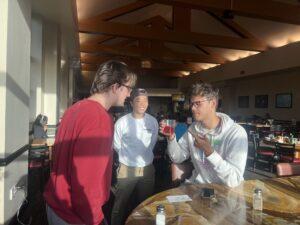
Playtest 4
- Who participated
- We conducted this playtest in class and had 4 participants (2 on each team). None of the participants were from our team.
- State of the game (what changed from the last playtest)
- 2.5 mins to make the drink
- 2 mins to guess
- Key assumptions we were testing/questions we were looking to answer
- How does time feel now (for both teams)?
- What dynamic is created by the mechanic of having quantities for the drink ingredients?
- Are players engaged?
- What we learned/decided
- Write ingredient quantities on the cards itself so it’s easier for the makers and they do not have to constantly juggle multiple things
- We added this to the design of our cards. It also followed gestalt principles of proximity/
- The makers felt quite restricted because of the cards and wanted a little more autonomy over the categories
- We combined some categories into one broader category eg. Tea and coffee were made into one ; spice and herbs were made into one etc.
- Timing for both the teams felt good now
- Scores was not enough incentive – more was needed so that people were motivated to play their best
- We added the concept of a “losing cup” that had to be drunk by the losing team at the end of the game (this could include crazy ingredients to make the stakes high) – this objective was more motivating than just points alone
- We debated a lot of possibilities, but decided it was best if this cup was made at the starting of the game (because no real power dynamics would be in play at that point) by both the teams together. This would also mean that both teams would know what was at stake if they lose and would be highly motivated throughout
- We added the concept of a “losing cup” that had to be drunk by the losing team at the end of the game (this could include crazy ingredients to make the stakes high) – this objective was more motivating than just points alone
- Write ingredient quantities on the cards itself so it’s easier for the makers and they do not have to constantly juggle multiple things

Further iterations we made:
Upon discussions, we decided to make changes to how the “losing cup” is made. At the start of the game, the 2 teams together start making a “losing cup” with 3 ingredients. In each round, if a team perfectly guesses all 4 ingredients, they can add 1 ingredient of their choice to the “losing cup”. This is to make the game stay engaging incase a team feels like they are just going to lose now and have no hope – this idea of still being able to influence the “losing cup” will keep everyone engaged each and every round.
Designs
Version 1:
This is the original ideation that we had. Simple fonts and emojis were used for the minimalistic style. The feedbacks that we have received from is that emojis might not be helpful if they don’t fit the theme and that we should think about incorporating a theme and sense of style into the game. An example that we received is the design approach from the game “Mixology.”
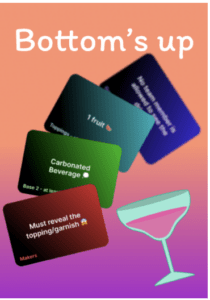
Version 2:
This is the second iteration that we had. We removed the emojis and put in more illustrations to attempt to create a sense of unified style. However, we received the feedback that the gradient in the background might be too distracting to the player. The illustrations should be more carefully placed, and the fonts should be more playful.
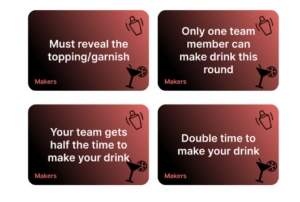
Version 3:
We have arrived at the latest iteration. We have incorporated all the feedbacks that we have received and redesigned the layout and the style of the cards. The gradients are removed, the orientation of the card is rearranged, the new fonts are incorporated, and we added variations to the illustrations depending on the content of the cards.
We have also designed the front and the back of the packaging with the newly designed cards and logos.
